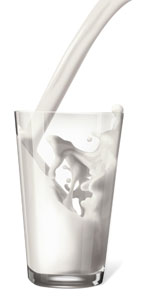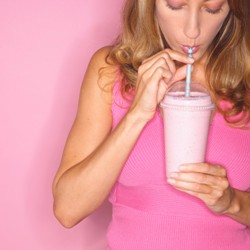It’s a well-known fact that the less fat there is in your milk, the less fat there’ll be in your pants. Equipped with this superior dairy knowledge, we often sway toward non-fat when making milk selections as opposed to whole when we’re trying to shed a few pounds.
I’m guilty of this myself and could’ve sworn my tighter pants and shortness of breath were attributed to my purchasing Vitamin D milk instead of my usual 1 percent last week at the store.
However, a bundle of new research is now contradicting that, saying that when it comes to milk, whole is king. But how is this so? Let’s start by looking at the facts.
At first glance, skim milk seems like the obvious winner with one cup containing just 83 calories and practically no fat. And when compared to its fattier counterparts, 2 percent falls slightly behind with 122 calories and 5 grams of fat; and whole milk comes in last with 146 calories and 8 grams of fat.
But as a recent article in Details Magazine points out, less calories doesn’t always equal more weight gain. This theory is backed by two recent studies – one in 2025, which found that obese participants who cut calories only saw temporary weight loss that didn’t stay off. And another in 2003, which, after comparing low-fat diets with low-calorie diets, found that the fat-restricted diets were no better than calorie-restricted diets at achieving long-term weight loss.
And according to another scholarly article on the topic from the Harvard School of Public Health, “Diets high in fat do not appear to be the primary cause of the high prevalence of excess body fat in our society, and reductions in fat will not be a solution.”
Another argument for going full-fat? It keeps you fuller longer and slows the release of sugar in your bloodstream, which reduces the amount that can ultimately be stored as fat. And a 2005 study from Harvard also found that low-fat milks are actually associated with weight gain, as opposed to their dairy fat counterparts.
 But perhaps the final blow in the full vs. skim debate is that contrary to popular belief, fuller fat milk doesn’t raise our bad (LDL) cholesterol. As stated in Detail Magazine, “LDL comes in at least four varieties, and only the smallest and densest of them are linked with heart disease. Dairy fat, it turns out, affects only the large fluffy kind of LDL – the benign kind.”
But perhaps the final blow in the full vs. skim debate is that contrary to popular belief, fuller fat milk doesn’t raise our bad (LDL) cholesterol. As stated in Detail Magazine, “LDL comes in at least four varieties, and only the smallest and densest of them are linked with heart disease. Dairy fat, it turns out, affects only the large fluffy kind of LDL – the benign kind.”
And as if we needed one more reason to stay away from skim, it’s made white through a complicated process that essentially fortifies it with powdered skim. This suspicious ingredient, known as oxidized cholesterol, not only sounds gross, but has also been found to be mutagenic and carcinogenic and even increase aortic cholesterol, according to a 1996 study from Spain. And just in case you’re getting around this one with organic milk, it’s in there, too.
So as it turns out, 2 percent and whole milk may not be so bad for us after all. After years of teetering back in forth between skim and full fat, I think I’ll be taking the higher road – the fattier road – from here on out. And I don’t think my skinny jeans – or my heart – will endure any suffering because of it.
Also Read:
Chocolate Milk the Best Post-Workout Recovery Drink
Hormone-Free Milk Can Keep Its Label
Pros and Cons of Milk Alternatives
